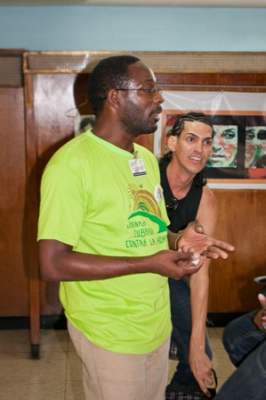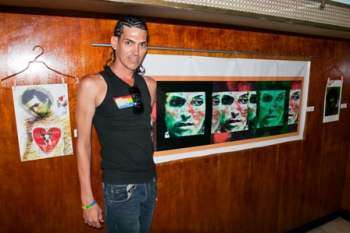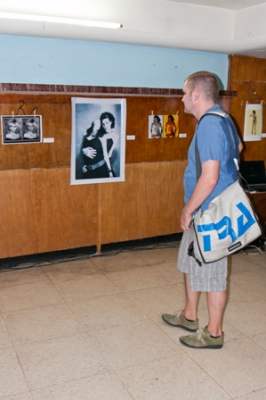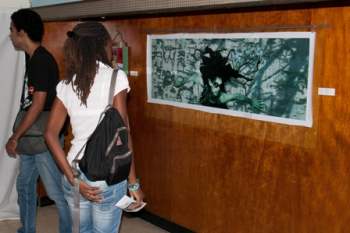The Making of “Miss Pop”
By Yusimi Rodriguez

HAVANA TIMES, May 25 – It all began when Michel (Nonardo) Perea participated in the “Voices of Change” competition in 2008. Up until then, he had been using a faulty typewriter or a borrowed computer to write his stories. Later, he would struggle to find a place to print them. He almost never won, especially when the prize was in cold cash.
This time, as on other occasions, months passed without a phone call and he forgot all about the competition. Nearly a year later he discovered that he had won first prize, consisting of 500 convertible pesos (US $550), a considerable sum of money.
And Nonardo, – like Martina the Little Cockroach (a Cuban story) thought to himself: “What shall I buy?- a color TV, a washing machine, a sound system? Or should I fix up the bathroom? Maybe I should paint my house?” He settled on the purchase of a computer. Everyone knows how important and extremely difficult it is to own a computer in Cuba.

Nonardo bought himself a secondhand laptop so he could write his pieces without having to journey to wherever a borrowed computer might be available. As a result, he discovered that he could use the machine for other things as well. And – Eureka! – He discovered Photoshop.
People have always liked taking his picture, and he has always enjoyed posing as a transvestite or with his natural appearance. But now he could manipulate the photos and achieve something new, go beyond the original photograph and transmit his own message, create his own fantasy. It proved very entertaining and he began enjoying it more and more. The next thing he knew he had more than thirty doctored photos, and had many more ideas. But he needed to find someone to take more photos of him.
As it happened, I too needed a photographer for an interview that I wanted to do of Michel. It was to be published in the Havana Times. (http://havanatimes.org/?p=28460 English http://havanatimes.org/sp/?p=7894 Spanish). However, I was reluctant to ask any of the site’s photographers to accompany me to Coco Solo, the neighborhood where Michel lives. Those who reside outside of Cuba don’t know where this place is, and many of those who do live here have never heard the name “Coco Solo” mentioned.” I’ll tell you clearly so you understand: Michel lives in the devil’s backyard.

We were discussing this in front of Bernardo, who manages the computers at a literary center, but that’s only his outer façade. That day he suddenly revealed to us his true identity: “I’m a photographer.”
He accompanied me in the rain to Coco Solo to take photographs for the interview. When he saw what Michel had in his hands he immediately decided to become an accomplice and was transformed into the principal photographer for the Miss Pop exposition. Others involved included Efain Galindo – a young producer of audiovisuals, director of a documentary about Michal (Nonardo) Perea and his photographic works – who also posed for a few photos; Luis Alfredo Vaillant, a doctor and writer; and Enrique Duran, another friend.
Michel has never set foot in an art school. Armed with nothing more than his little laptop and his immense imagination, he began to conceive the Miss Pop photographic exposition. He combined his own figure – the protagonist of all the pieces – with elements of pop iconography and famous artists from Marilyn Monroe to Andy Warhol, not to mention his idol Madonna.

But where would he ever find a place to exhibit this art so evidently gay? His work isn’t subtle; it’s as openly gay as it could be. Michel exploits the androgynous content of his image and exhibits himself without the least pinch of modest caution.
He cross-dresses from the inside out. There’s a bit of everything here: eroticism, beauty, violence. Nonetheless, it didn’t prove difficult at all to obtain space: only a couple of photos were censored. The exposition will be held in July in the Fayad Jamis Gallery of the East Havana Municipality.
At the same time, it occurred to Luis Vaillant that he could show part of the works of Michel in the Centro Cultural Literario Habana during this year’s May Campaign against Homophobia. From one moment to the next, he became the exhibit’s producer and Michel’s representative. The only thing missing were the photos. Yes, because the photos still had to be printed. Printing costs money.
Michel was working in the Paper Maché workshop in Old Havana. Under normal circumstances he earned a bit over one hundred regular pesos (US $4.50) every two weeks, but when there were slack times he would get only forty. And such slowdowns were the norm for him throughout almost all of 2002, 2010 and part of 2011.
When you’ve got friends
The cost of printing each photo 10 by 15 inches, costs almost the equivalent of 50 pesos in national currency. In other words, forget about the exposition. That’s when Michel’s most valuable asset came to light: a million friends, as the song says.

He met Michel García (who shares his first name) towards the end of 2003 when they were both taking a course in Narrative Technique organized by the Centro de Formación Literaria Onelio Jorge Cardoso. They had become fast friends, but towards the end of 2007 Garcia felt called to invest his modest efforts in other lands; he now lives in Spain.
He was able to send some money to Perea to print at least part of the photos for the exhibition. Rubén, a Spanish friend, also sent money and printed some of the photos in his country. Gonzalo, another Spanish friend, should also be sending some photos that will arrive in time to be exhibited in July show.
But Michel has had so much luck that even people who don’t know him have agreed to help him. Fuster Christian is a Swiss citizen who doesn’t even speak Spanish. One day he received an e-mail from a Cuban friend who related in her very bad German the story of Michel’s exhibition and asked him: Could you print up some of the photos in large format in Switzerland?
Fusti, as his friends call him, agreed. But shipping is very expensive. Someone else would have to bring them to Cuba or pay for them to be sent. This gauntlet was taken up by Alina Pupo, a friend of Michel’s who has been living in Switzerland for a few years. But then Fusti offered to print six additional pieces in Ecuador. He brought them personally on May 3; large photos printed on very high quality and lasting material.
Meanwhile, the ideas keep coming. Bernardo went to Michel’s house with his camera to hold a new photo sesion. He brought his friend Day G. Muguercia, who ended up posing with Michel in several of the photos.

Agnes Fong, a designer for the Habaguanex firm, read Michel’s interview in the Havana Times, saw the pictures, and ended up creating the Miss Pop poster. Everything was set – or almost everything. How were the photos to be mounted? Michel didn’t have enough to cover frames or glass covers. The Centro Cultural Literario Habana didn’t have the means to provide them.
Trying self employment
Meanwhile, during the time the exhibition was being prepared, Michel had to continue somehow making a living. After more than a year laid off (on slowdown at the workshop) he had to choose between becoming a cleaning assistant, taking a tailoring course a large distance away from his municipality, or taking out a license to become self-employed.
He opted for the latter and began to work with his cousin’s husband in a private coffee shop. The wages were promising – 60 to 80 pesos a day. There were only a few small problems – he had to do the work of two people by himself: serve, take the money and clean for 13 hours a day.
When he would get home, he wouldn’t have time to write or to work on his digital photos. And if he did find a little time, he couldn’t do it anyway, because he felt so tired it was if he had been beaten to a pulp. He didn’t get a regular day off on a Saturday or a Sunday, or even a Tuesday, but on whatever day his boss decided.
He couldn’t miss setting up the exposition or being present at the inauguration. He would have to choose between his art (which almost never provides him with a living) and food (without which you can neither live nor do art). After meditating most of the night on Tuesday, May 10, Michel went off to work at the coffee shop the next day…for the last time.

On Tuesday, May 17, the day which marks the “Campaign against Homophobia” the Miss Pop show was inaugurated in the Centro Cultural Literario Habana. Luis Alfredo Vaillant wrote the catalogue. The public gathered at the foot of the ladder that leads to the exhibition. Suspense filled the air.
When we finally went up, we saw the photos pinned to clothing racks with bobby pins. This surprised people and they commented: “How original!” As we went from photo to photo, we almost didn’t notice that we were moving to the rhythm of a discoteque song, “Descúbreme”, that was playing on Michel’s lap top, accompanied by the photos which had not yet been printed.
But the song in reality offers a tip as to what come next. It’s a video clip against homophobia composed and produced by Michel. The video clip is currently in the phase of post-production. Michel wants to enter it in the Cuban “Lucas” video clip competition. Ernesto Pérez produced the music, and another Ernesto, this one with the last name of René, and Milena Almira directed the clip; Michel, of course, is the protagonist. His cousin Lola donated the costumes.
Michel is pleased, even though he doesn’t expect that the exhibition will yield a great return. Efforts don’t always yield the fruits you hope for, nor in the moment that you expect them. Miss Pop might receive poor reviews, or not receive any, passing unperceived in the Cuban artistic world.
In order to gain notice, a critic is needed, someone to write about the exposition. The ideal outcome would be that he could sell one of the photos, but he knows that this is a remote possibility. Perhaps the best thing about Miss Pop is the fact that so many friends were involved in getting it to happen at all. And that they have succeeded in achieving this. Miss Pop is now a reality. From here on, this Lady has a long road to travel.





